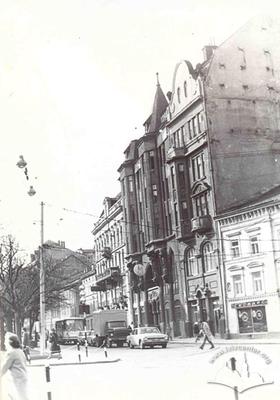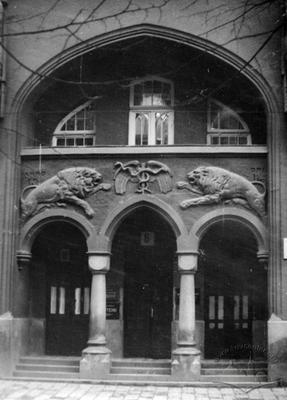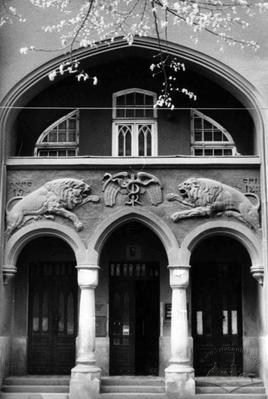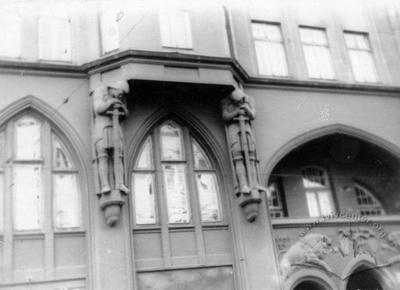Vul. Kniazia Romana, 06 – Lviv Radio office building
The five-storied building is situated in the row housing of Kniazia Romana street. It was built as a residential townhouse owned by merchants Ludwik Stadtmüller and Karol Czudżak under a project designed by architect Adolf Piller. The building is an example of early Modernist architecture. Its style combines some motifs of the Jugendstil, Neo-Gothic, and Secession (Art Nouveau) styles. It is an architectural monument of local significance (protection number 1199). Today it is occupied by the Lviv State Regional Radio and by the Lviv Regional Broadcasting Center.
Architecture
The monumental five-storied building stands in the row housing of the block located between Kniazia Romana and Nyzhankivskoho streets and the Halytska square. It is the architectural dominant of the beginning of Kniazia Romana street and the Halytska square. The building is constructed on a reinforced concrete frame, with plastered brick enclosing walls and partitions. In the décor of its façades granite is used.
In plan, the building has a trapezoid shape, with four small courtyards. A block, composed of two staircases and a lift and illuminated via a skylight, is located in the center. On perimeter, the block is surrounded by a corridor connecting it with the rest of the premises. According to the original project, toilets, baths, kitchens, and other ancillary facilities were located near the courtyards. Large and spacious living rooms were arranged exclusively on the sides overlooking the streets for better natural lighting.
The main façade facing Kniazia Romana street is symmetrical, with five compositional axes. The first two floors on the façade having large shop windows are separated by a cornice. The entrance, located on the central axis, is accentuated by a portico with granite Neo-Romanesque columns. Above the arches, there is a bas-relief composition with two lions and a caduceus, the symbol of successful enterprise. The portico supports the second floor balcony. At the level of floors 3-5 the façade composition is accentuated by vertical lines. On the second and fourth axes, there are two symmetrical faceted bay windows. The remaining windows are separated by profiled lesenes. The bay windows are topped with Neo-Gothic spires. The building has a gable roof covered with tin. The roof’s front part is steep, with a slope of about 60°. The other part of the roof is more gentle, with a slope of about 45°.
The rear façade facing Nyzhankivskoho street is symmetrical, with seven compositional axes. In its center, there is a three-storied bay window with an attic. The division of this façade is similar to that of the main one; however, no style decorations are used there. According to the original design, the façade was to have a late Secession attic with vases, rusticated lesenes, molded interfenestral inserts and Neoclassicist wreaths in the portal décor.
In the interior of the building, wooden Neo-Gothic doors with original glazing (glasses with facets) have been preserved. The floor in the hallway and in the staircase is covered with tiles. In the interior, especially on the second floor, where the Lviv Radio offices are located, original interiors have partially survived. Reinforced concrete pillars of the frame and girders with Neo-Gothic profiling (facets and a ¾ shaft) are seen quite clearly. The lower part of the walls is separated by a Secession-style frieze with molding in the form of grape bunches. Above on the walls, there are panels with Neo-Gothic tracery; there probably were some paintings inside earlier. On the ceiling between the girders, there are rosettes with tracery, whose form is borrowed from the Flamboyant Gothic style. In the center of the rosettes, chandeliers are mounted. Thus, the interior décor is quite eclectic. Initially, the second floor premiseswere occupied by a coffee shop named Ziemiańska.Personalities
Karol Czudżak — a
Lviv entrepreneur who owned a famous factory "Merkury", a co-owner of
the house.
Jan Krzysztofowicz — the owner of the house mentioned in a
1935 address book.
Adolf Piller
(1877-1951) — a Lviv architect who studied in Lviv, Karlsruhe, and Munich, the
owner of the architectural bureau where the house project was designed.
Stanisław Ryszard Plichal (approx. 1877-?) — a Lviv sculptor.
Ludwik Stadtmüller —
a Lviv entrepreneur who owned a folwark near Lviv, a co-owner of the house.
Roman Völpel (1880-1940) — an
architect who studied in Lviv and Vienna and worked in the architectural bureau
of Adolf Piller.
Sources
2. Юрій Бірюльов, "Архітектура початку ХХ ст.", Архітектура Львова: Час і стилі ХІІІ-ХХІ ст., ред. Ю. Бірюльов (Львів: Центр Європи, 2008, 720).
3. Jakub Lewicki, Między tradycją a nowoczesnością: Architektura Lwowa lat 1893–1918 (Warszawa: Towarzystwo Opieki nad Zabytkami, Wydawnictwo Neriton, 2005, 590).
3. Jurij Biriuliow, Rzeźba lwowska od połowy XVIII wieku do 1939 roku: Od zapowiedzi klasycyzmu do awangardy, (Warszawa Wydawnictwo Neriton, 2007, 388).
4. Krzysztof Sagan, Lwowska Fala. Najweselsza rozgłośnia PR w II RP.
5. Andrzej Skrzypczak, Z dziejów księgarstwa lwowskiego, (Warszawa, Instytut Lwowski, 1992).
6. Mieczysław Oktaw Pietruski, Trzy cwarte wieku z radiem. Zeznania seniora na LXXX urodziny Polskiego Radia (Lwów-Warszawa, 2004).
7. Skorowidz krolewskiego stolecznego miasta Lwowa (Lemberg, 1916).
8. Księga adresowa król. stol. miasta Lwowa, 1910.
9. Księga adresowa król. stol. miasta Lwowa, 1913.
10. Księga adresowa Małopołski, Wykaz domów na obszarze miasta Lwowa (Lwów. Stanisławów. Tarnopól, 1935–1936).
Media Archive Materials
Related Pictures















